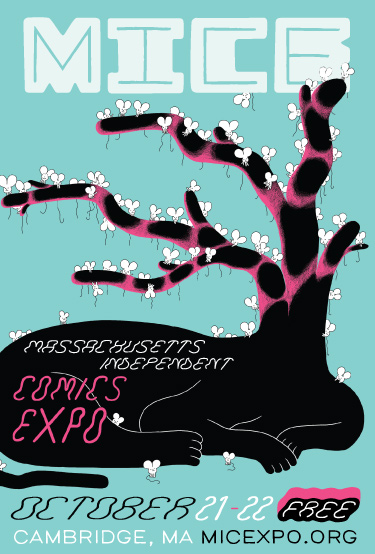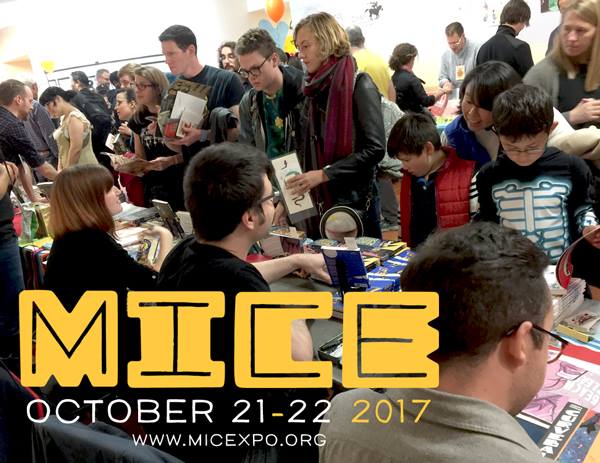As temperatures dip into the 60s and pumpkin-flavored items start their seasonal relationship with our stomachs, my heart flutters in excitement for the loveliest sign of fall: The MICE Expo.
Last year I experienced my 1st MICE Expo; a friend and I caught the last few hours of the Sunday session and quickly regretted 1.) not coming earlier & 2.)not attending both days. While we zoomed through the expansive University Hall grabbing business cards from artists and scooping up comics, I was in awe of how genuinely welcoming this 2 day event is.
The Massachusetts Independent Comics Expo, better known as MICE, is an annual 2 day event that showcases a number of local comics and artists. Located just a stone’s throw from the Porter Square T stop, attendees get to spend hours in Lesley University’s University Hall filling their arms with fresh comics, connecting with artists & participating in thought-provoking workshops and panels
Dan Mazur, one of MICE’s co-directors, took the time to chat with Allston Pudding about comics, the program curation process and why folks should head out to MICE this weekend!
AP: What was the 1st comic you read that had a profound impact on you?
DM: When I was a kid, and this was in the 60s and 70s, I learned a lot from comics. It seemed like simple entertainment, but the writers slipped in historical references, politics, even poetry (I remember reading passages of Coleridge’s “Kublai Kahn” and Emily Dickinson’s “Because I Couldn’t Stop for Death” in different issues of Batman). They were also full of cool fantasy and sci-fi concepts, that of course as a kid, you’re being introduced to for the first time. The one example I always think of was an issue of “The Atom,” a second-tier DC superhero who can shrink. In this one issue, he shrinks so small that he ends up in another world in a sub-atomic universe, in which he’s a giant, and he’s terrorizing all the people in this tiny world. That blew my 8 year old mind, and I still think there’s something deep and philosophical about that story.
AP: What moved you to organize MICE?
DM: Shelli Paroline and I organized the first MICE back in 2010. We were both part of the Boston Comics Roundtable, which was about 4 years old at that point (now having its 11th anniversary), so we knew that there were lots of comic-makers here and no indie comics show, so in a way it was a no-brainer. I think we started it, really, because we both just really loved exhibiting at zine fairs and independent comics shows; they were – and are – among other things, a great, creative social gathering for cartoonists and we wanted there to be another one. Over the years, MICE has become a lot more than a weekend party for independent comics creators, but I like to think it’s still that.
AP: What’s the process of developing the programming for MICE?
DM: It’s a combination of brainstorming ideas for panels and workshops we’d like to see and going carefully through our list of exhibitors to see what special talents or themes we can put at the forefront. For the workshops, there’s a tilt toward creative activities that will appeal to kids, but not exclusively, so all ages might enjoy an animal drawing workshop. There are also more sophisticated workshops that deal with story-telling techniques in comics that are very specific to those who create comics. For the panel discussions, we try to find subjects that will appeal to both artists and non-artists alike, and just to be attuned to what’s going on in the comics world, and the world in general. We really want to show the connection between comics and other topics — this year we have Comics & Islam, Comics & Poetry, Comics & Immigration, among others.
AP: What are some of your favorite comics you’ve read this year? What comics are you currently reading?
DM: This may sound like shameless promotion, but just about my favorite comic I’ve read this year is by one of our special guests: “Demon” by Jason Shiga. It has a cute, rounded drawing style but, the story is gruesome, dark and weird. It starts with the main character killing himself and coming back to life over and over again; it has the plotting of a very cool supernatural thriller but so quirky that nothing is ever predictable. I’m generally not a mainstream comics reader so I’m usually reading mini-comics, like the ones you can only find at shows like MICE, or graphic novels. This year everyone has been talking about a graphic novel called “My Favorite Thing is Monsters,” by Emil Ferris which is a pretty fascinating comic; sprawling and ambitious. Story-wise, I found it kind of a mess at times but it has some of the most amazing artwork — all drawn with ballpoint pens I think. Definitely worth a look to stretch your concept of what a comic can be in terms of content, style and technique. Right now I’m really into the books of an Italian artist named Manuele Fior, who does beautiful watercolor comics. Some of his titles are “5000 KM per Second,” “The Interview,” and “Mademoiselle Else” which was adapted from a story by Arthur Schnitzler and looks like a comic drawn by Munch or Bonnard.
AP: What are 3 big dreams/goals you have for MICE in the coming years?
DM: Goals for MICE include sponsoring events year-round, bringing comic artists to town to do readings and signings, or have local artists put on presentations of their work; essentially to keep indie comics in the public consciousness 365 days a year. Getting more involved with comics education and community outreach, especially in under-served communities around Boston. Teaming up with cultural departments of embassies and consulates to bring in more international creators. Teaming up with the City of Cambridge or other local governments to expand the idea of a comics festival that could go beyond the 2-day event in a single location. But if MICE just stays as good as it is now, that’d be fine too.
AP: If scheduling & cost wasn’t a factor, who would you like to speak at MICE and why?
DM: The great thing is how many of our “dream guests” we’ve succeeded in bringing in. Three or four names come to mind, depending on how you count, that we’ve talked about for years but haven’t succeeded in bringing here…..yet. Alison Bechdel, who is brilliant, and whose work really opened a lot of people’s eyes to what comics could be and do. We even named one of our exhibition rooms after her. I will boldly predict she’ll be our special guest in 2018 or 2019. Another is Lynda Barry, who not only is a great cartoonists but one of the most inspiring speakers in comics. In fact, I saw her and Bechdel together at Wellesley about 10 years ago and they made a great team; we could reunite them at MICE. Another heroic duo, indie-comics-style, are the Hernandez Brothers, who write and draw “Love and Rockets,” they would definitely be “dream guests” but not impossible.
AP: Scenario: I have never heard of MICE, why should I go & what can I expect?
DM: You should come to MICE to luxuriate in the fantastic & fun art and storytelling that is the DIY & independent comics scene of today — overlapping with the graphic novel publishing industry as well. MICE is small, but in terms of the caliber of the artists that you’ll meet there, it’s right up there with the best independent comics shows in the country (SPX in Bethesda, Maryland; CXC in Columbus, OH; CAB in Brooklyn and a few others). Of course I’m biased, but if you live in the Boston area, you should be too. And cartoonists are just really nice people, if generally a little odd. Plus it’s free.
MICE will be held at Lesley University’s University Hall at 1815 Massachusetts Avenue in Porter Square. The hours of the show are Saturday, October 21st, 10 am – 6 pm, and Sunday, October 22nd, 11 am – 5 pm. Admission is free. For more info, check out their website.
Note: Illustrators and artists will have their work available for purchase at the expo so prepare accordingly; I recommend a sturdy tote bag…or 2.

Poster Illustration by Michael Deforge

